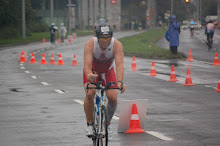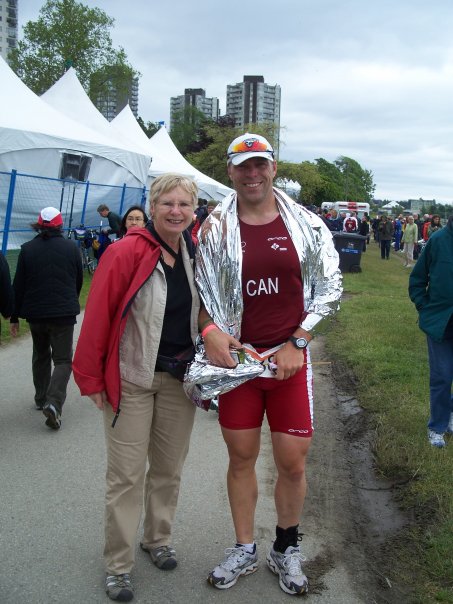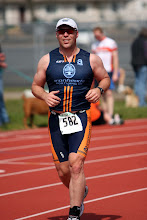On Sunday, I was asked why is it that I may be competing in the disabled/AWAD (athlete with a disability)/PC (physically challenged) category at ITU World's in June. Its not the first time I have been asked about my injury and I know it wont be the last but I dont mind when I get this question. I dont look like someone with a disability. I certainly try and go out of my way to not show it, but every so often, I limp, and someone will ask about it so I thought I would share.
For those of you that have heard this story, guess this is where you should stop reading.
On November 1, 2002, I went into OHSU (Oregon Health Sciences University) for a routine procedure to embolize a soft tissue tumor on my back. The tumor is called a hemangioma, a benign mass, but nonetheless, HUGE. I still have it by the way, its 7cm x 8cm x 15cm, on my left posterior flank, just under my scapula..... Too much medical jargon, its on the left side of my back just under my shoulder blade. Back to the procedure. They were looking at the mass via angiography and trying to put these little microspheres (I call them ball bearings) into the blood vessels that were feeding the tumor in hopes of killing it off. I guess, when they were pushing the scope up through the aorta, against the flow of blood, a clot was formed which tumbled downstream and into the artery that feeds the spinal cord at the level of the 8th thoracic vertebra. The clot caused an infarct (same as a stroke) basically meaning the front left part of my spinal cord was left without blood/O2 supply for who knows how long. The result was a loss of motor function of everything from T8 down (around my belly button) but only on the left side, and a loss of sensation on the right, same level. This condition is known as Brown Sequard Syndrome.
After three days in OHSU, 11 days at RIO (Rehab Institute of Oregon), I was kicked out (Kaiser didnt want to pay anymore) because I was able to dress myself. I still couldnt walk, Kaiser wouldnt buy me a wheelchair because crutches were available, and I had to figure out how to drive my manual transmission truck to out patient PT. Because Im a male, full of testosterone, etc, yada yada yada, I figured out that locking out my knee when standing or limping along would make me not have to use my crutches. I also figured out that locking my knee makes for a bad trip down the stairs, but thats another story. I had foot drop too but if I wore cowboy boots, I didnt have to use the AFO brace (ankle foot orthosis) which was huge, and didnt fit into any of my shoes.
In the six months following my injury, most of my muscle function returned, some of the muscles reached a plateau and to this day are still weak. I still have some diminished sensation on the right side as well. My 5 year old loves to ask which leg I cant feel, I point to it, then he kicks me and asks me if I felt it.
Right after I was transferred to RIO, I began searching for wheelchair sports I could compete in. I didnt think I would walk again without crutches and being involved in sports all my life, I had a need to compete in ANYTHING. During my search, I found the Challenged Athletes Foundation, a non profit orgainization that grants money to PC athletes for equipment, specialized training, or travel to PC events. I began raising money for them and training for my first half iron distance triathlon. Prior to my injury, I had done 5 sprint tri's and a bunch of mountain bike races but nothing longer than 2-3 hours.
On October 31, 2004, two years less a day from my original injury, I finished my first 70.3 in 7:40. It was a long day but I fully enjoyed it. Since then, I have done three 70.3's and Ironman FL. IMNA doesnt have a PC category unless you are missing limbs or are in a wheelchair so I have to participate, not compete in IM distance events. The ITU, on the other hand, has revamped their AWAD categories and I hope to be classed as a TRI3.
I have adapted to many things since November 1, 2002. Some of it good, some bad. I have a lot of bad habits that need correcting posturally, gait wise, and other things that have given me a lot of imbalance in my lower half. I trained for the 2006 Ironman FL to walk the entire course except for the last 200m or so where I shuffle jogged. Last year, my coach, Scott McMillan, helped me get running a little. Enough so I shuffled most of Blue Lake Oly, and over half of Lake Stevens 70.3. In June, I plan on running, yep, running, the whole thing. I have an ankle brace I wear to stop me from breaking my ankle and limits my foot drop. As a result of the foot drop I still have, my left calf is very tight as I land on my forefoot all the time. Because of the compensatory changes, my right hip is constantly sore and my left medial knee get some periodic pain. I used to hate distance running when I was able to (I was a sprinter in high school) and I dont love it now but I REALLY want to be taken back to when I was able bodied and see how much I could improve..... but I digress.
I recently had an impairment exam to determine my overall disability percentage. I needed that to be done so I can compete in the ITU "les autres" category which says I have to have >15% impairment to be called AWAD (athlete with a disability)/PC (physically challenged). If I have less than 15%, I have to compete as an age grouper or my favourite class, Clydesdale. Any way you slice it, I couldnt have made it this far, physically or mentally, without my family, friends, and my coach.
Anyway, thats me in a nutshell. Feel free to ask any questions about me or the Challenged Athletes Foundation. Im an open book. Once you spend 2 weeks in a hospital, things are no longer that embarassing or off limits.
Monday, April 21, 2008
Subscribe to:
Post Comments (Atom)




2 comments:
Keep it up man.
Inspire.
Keep up the positive work brother! Hope to see you at worlds this year. Best.
Nick
www.runnickrun.org
Post a Comment